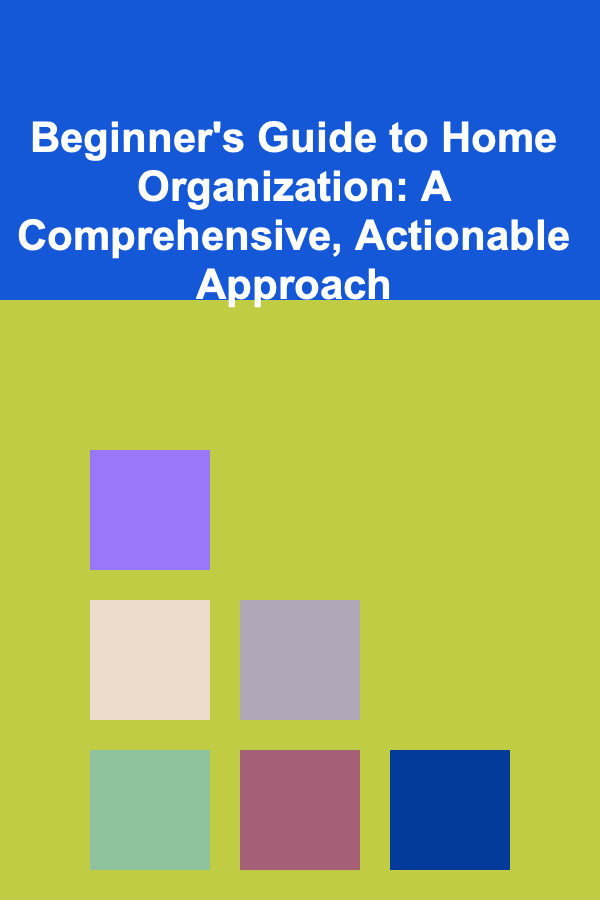
Beginner's Guide to Home Organization: A Comprehensive, Actionable Approach
ebook include PDF & Audio bundle (Micro Guide)
$12.99$9.99
Limited Time Offer! Order within the next:

Organizing your home can feel like an overwhelming task, especially when you're just starting. Whether you're moving into a new home, downsizing, or simply looking to create a more peaceful and functional space, home organization is a journey worth taking. A well-organized home doesn't just improve aesthetics but enhances your productivity, mental clarity, and overall well-being. In this beginner's guide, we'll walk you through actionable steps that you can follow to declutter, organize, and maintain your home.
Understanding the Importance of Home Organization
Before diving into the steps, it's essential to understand why home organization matters. It's not just about aesthetics; it's about creating a living environment that promotes well-being and productivity. Here are some of the key benefits:
- Reduced Stress: Clutter can contribute to feelings of anxiety and overwhelm. An organized home reduces these stressors and gives you a sense of control over your environment.
- Improved Productivity: When everything has its place, you save time looking for things, allowing you to be more productive.
- Better Time Management: With an organized home, daily chores become easier and faster, freeing up your time for more enjoyable activities.
- Mental Clarity: A clean and tidy space fosters mental clarity, making it easier to focus on tasks and relax.
Step 1: Start with a Vision
The first step in home organization is determining your vision. Before you start throwing things away or moving items around, ask yourself what you want to achieve. Think about the atmosphere you want to create in each room. For example:
- Living Room: Should it be a space for relaxation and family gatherings, or does it need to double as a work area?
- Kitchen: Is your kitchen cluttered with gadgets you rarely use, or do you need to streamline your kitchen tools for efficiency?
- Bedroom: Do you want a peaceful sanctuary, or is your goal to have an organized storage solution for clothes and other items?
Having a clear vision for each area will help guide your organizing decisions and ensure that the changes you make serve your lifestyle.
Step 2: Declutter Everything
One of the most crucial steps in organizing your home is decluttering. Before organizing items into neat spaces, it's essential to reduce the number of things you have.
How to Declutter:
- Set a Time Limit: Start by allocating a set amount of time for each area. For example, you could dedicate 30 minutes to decluttering a single drawer or 2 hours to organizing a closet.
- Sort and Categorize: Pick an area or room and go through every item. Create piles for things you want to keep, donate, sell, or throw away. Be ruthless. If you haven't used something in the past year, it's time to consider parting with it.
- One Area at a Time: Avoid getting overwhelmed by tackling one area at a time. Start with a small space like a desk or drawer, then work your way up to larger spaces like closets or the living room.
- Follow the "Four-Box Method": As you declutter, use four boxes or bags: one for items to keep, one for things to donate, one for things to sell, and one for items to throw away.
Questions to Ask Yourself:
- Does this item bring value to my life?
- Do I use it regularly?
- Does it fit with the vision I have for this space?
Decluttering is not just about getting rid of things; it's about making room for things that truly add value to your home and life.
Step 3: Organize by Function
Once you've decluttered, the next step is organizing the remaining items. This is where the real transformation happens. Think about the functionality of each space and how you can arrange items in a way that works best for you.
General Tips for Organization:
- Group Similar Items Together: Store similar items in the same place. For example, group all cleaning supplies in one cabinet or all office supplies in one drawer.
- Use Bins, Baskets, and Labels: Invest in clear bins or baskets to store smaller items. Use labels to identify what's inside each container, so you can easily find what you need.
- Utilize Vertical Space: Don't forget to look up! Wall-mounted shelves, hooks, and pegboards can help you maximize space, especially in smaller rooms.
- Make Use of Hidden Spaces: Often, the best organization strategies involve utilizing hidden or underutilized spaces. Consider under-bed storage, over-the-door organizers, or inside closet organizers to store items that you don't need to access regularly.
- Optimize Closets and Drawers: Use drawer dividers and closet organizers to keep everything in place. Hanging organizers can store shoes, accessories, or seasonal clothing, while drawer dividers can organize jewelry, stationery, or kitchen tools.
Example: Organizing the Kitchen
- Drawers: Use dividers to organize utensils, cutlery, and kitchen tools.
- Countertops: Keep only the most used items on the counter, like a coffee maker or a fruit bowl, and store everything else out of sight.
- Pantry: Organize by categories like grains, canned goods, and snacks. Use baskets or clear containers for better visibility.
Step 4: Create a Maintenance Routine
An organized home only stays organized if you maintain it. To keep your space looking neat and functional, develop a routine that works for you. Here's how to maintain the organization:
Daily Habits:
- Make Your Bed: Starting your day with a simple task like making your bed can create an immediate sense of accomplishment and order.
- Put Things Away: Instead of leaving things around, make it a habit to put them back in their designated spots immediately after use.
- Nightly Reset: Spend 10-15 minutes each night tidying up your home. It could be as simple as putting away dishes, folding blankets, or wiping down counters.
Weekly Habits:
- Laundry: Stay on top of laundry by doing small loads throughout the week rather than letting it pile up. This keeps your wardrobe organized and reduces clutter.
- Declutter Small Spaces: Take time each week to clear out small areas that tend to accumulate clutter, such as countertops, tabletops, or entryways.
Monthly Habits:
- Review Items: Go through your closets, cabinets, or storage spaces and remove anything you no longer need. This will help you stay on top of decluttering without overwhelming yourself.
- Deep Cleaning: Once a month, do a more thorough cleaning of areas that are harder to maintain, like baseboards, windows, or under furniture.
Step 5: Stay Consistent and Adjust
Home organization isn't a one-time event---it's an ongoing process. You may need to adjust your systems as your needs change or as new items are added to your home. Be flexible with your organizational systems, and be patient with yourself as you develop new habits.
Tips for Long-Term Success:
- Evaluate Your Systems: Every few months, evaluate how your organizational systems are working. Are there areas that are consistently messy? If so, tweak your organization methods to make them more efficient.
- Avoid Overbuying: Be mindful of bringing new items into your home. Ask yourself if you truly need the item, and if it will add value to your life or contribute to clutter.
- Get the Family Involved: If you live with others, encourage everyone to participate in maintaining the organization. It's easier to keep a home organized when everyone is on board.
Final Thoughts
Organizing your home can feel daunting, but with a clear plan and consistent effort, it can become an incredibly rewarding process. By starting small, decluttering, and implementing practical organizational strategies, you'll create a space that enhances your productivity, reduces stress, and makes your home a place where you truly want to be.
Remember, the key to long-term success is consistency. Start with one room, develop daily and weekly habits, and adjust your systems as needed. With time and practice, you'll find yourself enjoying the benefits of a well-organized home.

How to Create a Smartphone App System for Home Tasks
Read More
How to Create an Efficient Pantry Organization System
Read More
How to Decorate Your Home for the Holidays with Kids' Crafts
Read More
How to Downsize Effectively for Senior Living
Read More
How to Host an Elegant Home Tea Party for Your Guests
Read More
How to Incorporate Multi-Functional Furniture in Your Bedroom
Read MoreOther Products

How to Create a Smartphone App System for Home Tasks
Read More
How to Create an Efficient Pantry Organization System
Read More
How to Decorate Your Home for the Holidays with Kids' Crafts
Read More
How to Downsize Effectively for Senior Living
Read More
How to Host an Elegant Home Tea Party for Your Guests
Read More